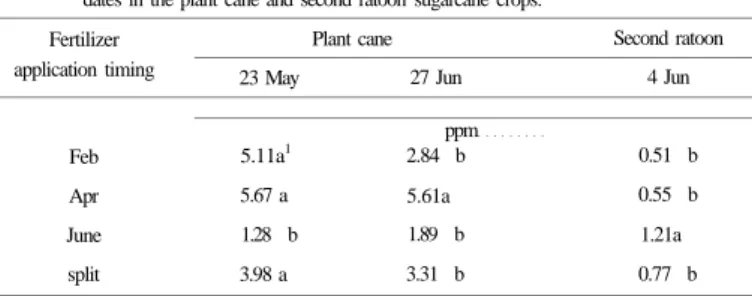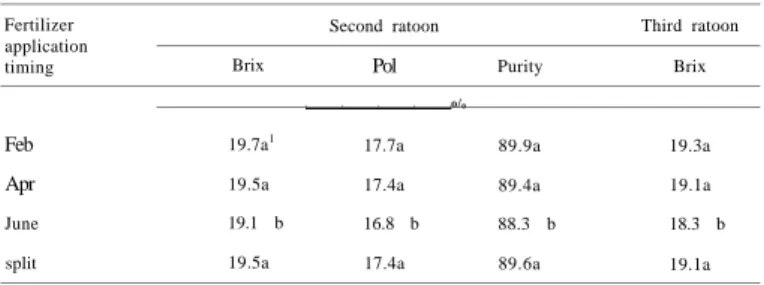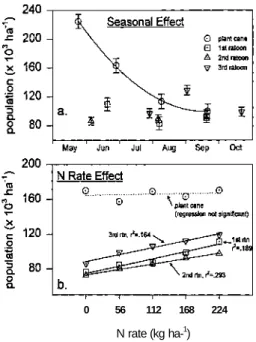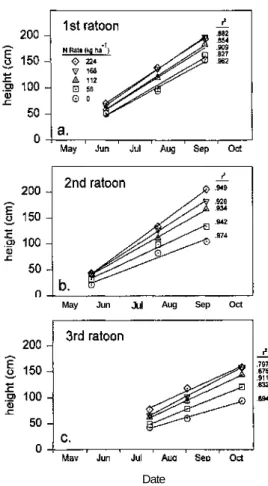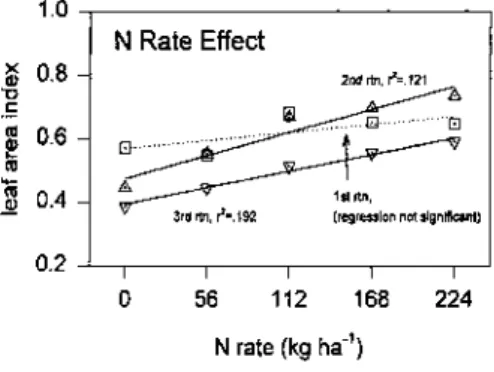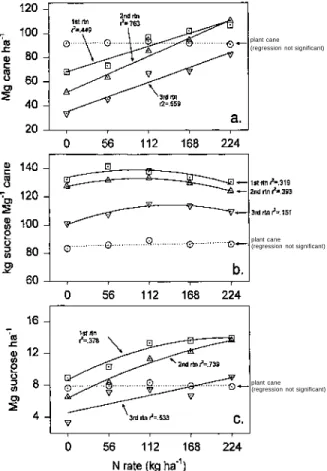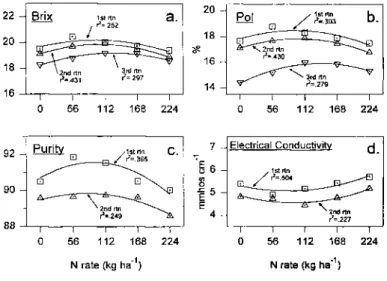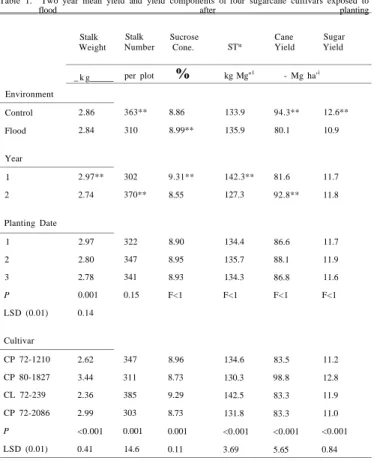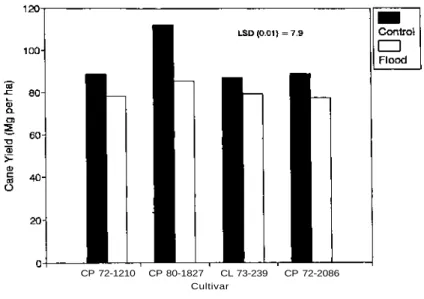I felt obliged to leave some brief advice for future editors, reviewers, and authors of the Journal of the American Society of Sugar Cane Technologists. Editorial Policy 114 Rule for Preparing Articles for Publication in the Journal of the American Society of Sugar.
PEER REFEREED
JOURNAL ARTICLES
AGRICULTURAL SECTION
- NCo 310 (2n=112 10 ) x IMP 3905 Miscanthus sinense (2n=38 8 )
- POJ 2725 (2n=107 17 ) x M japonicus (2n=38 17 )
- CP 79-348 (2n=112 10 ) x NG 77-199 Saccharum robustum (2n=166 8 )
- POJ 2222 (2n=107 this study ) x Open pollinated S. spontaneum
- L C P 85-384 (2n=106 t h i s study ) x Self
- H o C P 88-739 ( 2 n = l l l - 1 1 3 t h i s study ) x Self
Percentage reduction of stalk number due to flooding in the plant cane crop of four sugarcane cultivars. The remaining 13 main cultivars were still on the market in 1995; therefore their survival times are not yet known. Predicted survival times for each of the 29 cultivars used in the survival analysis were calculated from the selected Cox model (Table 2).
Based on this model, long survival cultivars are those that are released into a diverse market and capture a large share of the market in the first six years of production. The lifespan of cultivars is positively influenced by the great diversity during the year of introduction and the acquisition of a large market share in the first years after introduction. Herbicide treatments usually began in the first year's fall-planted crop (cane) and continued in the second and third year crops (ratoons) in many experiments.
The plots that received terbacil in the ratoon crop were treated with metribuzin at a dose of 1.6 kg/ha in the previous crops.
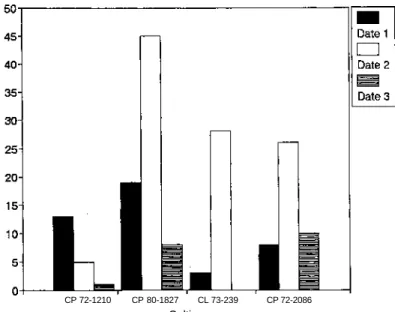
The first experiment, 3-row-wide by 8-m-long plots with 3 replications, was conducted in the plant cane crop only (1988-1989) and also included LHo 83-153 which was being considered for release at that time. The second experiment, 3-row 8-m-wide plots with 5 replications, was conducted over a full 3-year cycle (1990 to 1993) and included a treatment in which terbacil was applied only to the two ratoon crops with metribuzin in 1.6 kg/ha replacing terbacil in cane culture. In the cane culture with plants of the 3-year experiment, both asulam and terbacil also reduced the cane yield of all cultivars and caused large decreases in sugar yield (Table 2).
Asulam treatments in ratoon crops also reduced cane and sugar yields of all cultivars, resulting in an overall reduction of 9% in average annual cane and sugar yields over the 3-year crop cycle. As observed in the first experiment, reductions in cane yield by both asulam and terbacil were mainly caused by reduced stem population (data not shown). However, in the second experiment, LHo 83-153 was generally more tolerant than CP 72-370 to asulam and terbacil applied over a 3-year cropping cycle as shown by the significant cultivar by herbicide interaction on average annual cane yield and sugar (Table 4).
In the ratoon crop, no yield reduction occurred for LHo 83-153 at either site, while CP 70-321 had a 9% reduction at site 2.
- L. Legendre
This supports the claim that CL 61-620 was resistant to the isolate used in the experiment. An additional 60, 40, and 40 lbs/ac of N, K20, and P205 fertilizer, respectively, applied in the high treatment compared to the standard treatment did not significantly increase cane or sugar yield growth. Reducing the amount of nitrogen applied to a low rate (60 lbs/ac) significantly reduced the amount of nitrogen lost to surface runoff.
Reducing the amount of metribuzin applied and strips at the top of the cane row significantly reduced the amount lost to surface runoff. The grass that grows on the sides of the rows in the winter is removed by physical treatment in the spring. Our study was conducted to determine whether calcium N-HIB (supplied by Stoller Enterprises, Inc.; composed of 12% calcium as calcium chloride, 1.5% magnesium as magnesium chloride, and a urease inhibitor) could increase nitrogen use efficiency and sugar cane {Saccharum spp.) brings. The increase in sugar with the application of N-HIB Ca is due to the increased tonnage, which is due to the higher weight of the stem).
Of the various strains of sugarcane mosaic virus (SCMV) found in the US, strain H causes the greatest losses. We have compiled a collection of seven SCMV strains native to sugarcane in the US. A research project has been launched to investigate the colonization of barn owl nest boxes on the edge of sugar cane fields in the EAA.
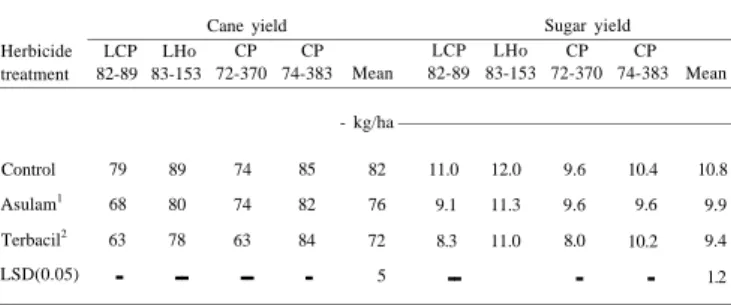
IMPROVING SUGAR RECOVERY WITH SUGAR PROCESS CHEMICALS
Journal of American Society of Sugar Cane Technologists, Vol. improved plant safety and protection of the environment. The Managing Editor writes to the person who submitted the paper to notify the author of receipt of the paper and the registration number to be used in all correspondence about it. When a paper is returned by reviewers, the Technical Editor evaluates the paper and the recommendations of the reviewers. If the paper as received by two reviewers is recommended for publication in the Journal, it is sent to the Managing Editor.
The paper registration form is completed and returned to the managing editor together with copies of the reviewers' statements and a copy of the technical editor's letter of forwarding to the author. The papers are sent by the Technical Editor to the Managing Editor, who notifies the authors of this fact and of the probable dates of publication. Papers submitted by the Technical Editor to the Managing Editor are prepared for printing according to their dates of original submission and final approval and according to the space available in the next issue of the journal.
RULES FOR THE PREPARATION OF ARTICLES FOR PRINT IN THE REVIEW OF THE AMERICAN ASSOCIATION OF SUGAR TECHNOLOGISTS TRS Format.
Name, Object and Domicile
Divisions
Membership and Dues
Overseas members or foreign members are individuals who do not reside in the continental United States and who may be interested in the objectives of the Society. The membership fee for an individual calendar year is paid no later than 3 months before the annual meeting of the member's department. Membership fees are collected by each department secretary-treasurer from the members in their respective departments.
Only members (all classes) have the privilege of speaking at society meetings. The secretary-treasurer is appointed by the department's executive committee and serves as a non-voting member. Each department, as described in Article VII, is represented in the offices of the President and Vice President.
In any given year, the presidents of the two divisions will be nominated and elected from different sections.
Division Committees
Sections
Meetings
At all meetings of the association's two departments, five percent of the active members constitute a quorum. The program for the association's annual meeting is organized by the general secretary-treasurer in collaboration with the joint executive committee. The Annual Meeting of the Louisiana Chapter shall be held in February of each year, at such time as shall be decided by the Chapter Executive Committee.
The annual meeting of the Florida Division shall be held in September or October of each year, at such time as the Executive Committee of that Division shall decide. Special meetings of a Division for the discussion of matters of particular importance to that Division may be called by the President at the request of the respective Chairman of a Division. At Section meetings, 10 percent of the active Section members and the President or a Vice-President shall constitute a quorum.
Management
Publications
The editor-in-chief shall be appointed by the Joint Executive Committee no later than six months before the start of his or her term of office. If the appointed editor-in-chief has served for more than one year but less than the full three-year term, the technical editor of the same division will fill the unexpired term of the outgoing editor-in-chief. The Journal of the American Society of Sugar Cane Technologists will have two technical editors, an agricultural editor and a manufacturing editor.
The editor-in-chief appoints the technical editors for a term not exceeding his or her term of office. Any member or non-member wishing to contribute to the Journal of the American Society of Sugar Cane Technologists must submit his or her manuscript to the Managing Editor. The Technical Editor will solicit peer reviews until, in the opinion of the Technical Editor, two responsible reviews have been obtained to accept (with or without major or minor revision) or reject the manuscript.
For articles accepted with major review, it will be the responsibility of the Technical Editor to decide whether the authors have satisfactorily completed the major review(s).
Amendments
The Division's affiliation of Managing Editors will alternate between the Divisions from quarter to quarter with the normal term of three years, unless the Division responsible for nominating the new Managing Editor reports that it has no suitable candidate. No one shall serve two consecutive terms unless there is no suitable candidate from any section willing to replace the current Managing Editor. If the Managing Editor serves less than one year of his or her three-year term, another candidate is nominated by the same Division, approved by the other Division and appointed by the General Secretary-Treasurer for a full three-year term.
In the event that the Technical Editor declines the appointment, the General Secretary-Treasurer will appoint an Editor-in-Chief from the same department to serve the unexpired term. Each department will be represented at all times by one technical editor, unless the executive committee of one department and the editor-in-chief agree that there is no suitable candidate willing to work from that department. The Editor-in-Chief serves as the technical editor of any manuscript that includes the Technical Editor as an author.
Dissolution
Assets

